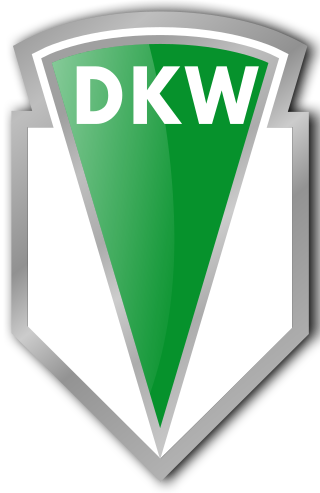
DKW was a German car- and motorcycle-marque. DKW was one of the four companies that formed Auto Union in 1932 and thus became an ancestor of the modern-day Audi company.

Auto Union AG, was an amalgamation of four German automobile manufacturers, founded in 1932 and established in 1936 in Chemnitz, Saxony. It is the immediate predecessor of Audi as it is known today.

JAWA is a motorcycle and moped manufacturer founded in Prague, Czechoslovakia in 1929 by František Janeček, who bought the motorcycle division of Wanderer. The name JAWA was established by concatenating the first letters of Janeček and Wanderer. In the past — especially in the 1950s — JAWA was one of the top motorcycle manufacturers and exported its 350 model to over 120 countries. The best known model was the 350 Pérák, and in the 1970s the 350 Californian. It appeared in typical black and red coloring from California to New Zealand. After 1990 a significant loss of production occurred. A successor company was formed in 1997 in Týnec nad Sázavou, continuing the name as JAWA Moto.

Pre-war Československá zbrojovka, akc.spol. and post-war Zbrojovka Brno, n.p.(Brno Armory) was a maker of small arms, light artillery, and motor vehicles in Brno, Czechoslovakia. It also made other products and tools, such as typewriters and early computers.

Walter Aircraft Engines is an aircraft engine manufacturer and former automotive manufacturer. Its notable products include the M601 turboprop. The company is based in Prague, Czech Republic. It has been a subsidiary of GE Aviation since July 2008.

The Tatra 70 is a Czechoslovak luxury car that was made by Tatra at Kopřivnice from 1931 to 1937. It succeeded the Tatra 31.
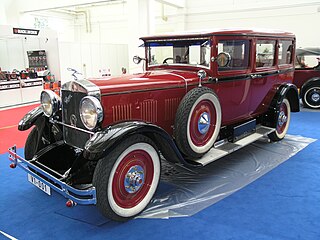
The Praga Grand was a luxury automobile manufactured by Praga in Libeň, Prague. Production of the first Grand, equipped with a four-cylinder engine, started in the Kingdom of Bohemia in 1912 and continued after the dissolution of Austro-Hungary in the First Czechoslovak Republic. It was used by the Austro-Hungarian Army during World War I as a staff car. The Praga Grand 8 introduced in 1927 had an eight-cylinder engine and was the official state car for the Czechoslovak president Tomáš Garrigue Masaryk. The car also achieved limited success in road racing.

The Škoda Rapid is a mid-size car that was made in Czechoslovakia by Škoda from 1935 to 1947. Škoda had first applied the "Rapid" name to a version of its 1,195 cc Popular Type 920 made in 1934–35. From 1935, however, it transferred the name to a new, larger model.

The Škoda Popular is a small family car that was made in Czechoslovakia by Škoda from 1933 to 1946. It was the company's most affordable car at the time.

The Zbrojovka Z 5 Express was a car produced by Československá Zbrojovka in the 1930s.

The Zbrojovka Z 6 Hurvínek was a car produced by Československá Zbrojovka in the 1930s. Originally developed as a smaller vehicle for sale alongside the Z 4, 400 of the car were sold between 1935 and 1938. The car was of conventional design and powered by liquid-cooled two stroke two cylinder engine, which propelled it to a top speed of 90 km/h (56 mph). It had sufficient range to drive between Prague and Brno.

The Škoda Favorit is a mid-size car that was made in Czechoslovakia by Škoda from 1936 to 1941. The original Favorit Type 904 has an 1,802 cc sidevalve engine and was built 1936–39. It was succeeded by the Favorit 2000 OHV which has a 2,091 cc overhead valve engine and was built 1938–41.
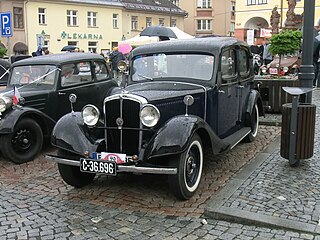
The Škoda 633 is a Czechoslovak mid-size car that was made by Škoda from 1931 to 1934.
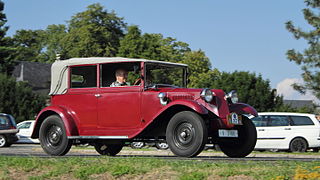
The Tatra 52 is a Czechoslovak mid-size car that was made by Závody Tatra from 1931 to 1939. It was built both at the Tatra factory in Kopřivnice and also under licence at Frankfurt am Main in Germany.

The Praga Alfa was the name used by Praga in Czechoslovakia for one of its principal car ranges. Production started in 1913 and finished in 1942.

The Praga Super Piccolo was a car produced by Praga in Czechoslovakia between 1934 and 1936.

J.Walter a spol. (1911), Akciová továrna automobilů Josef Walter a spol. (1919) and Akciová společnost Walter, továrna na automobily a letecké motory (1932) was an automotive manufacturer. The company was based in Prague, Czech Republic. The plant survived the war intact and in 1946 the company was nationalized as Motorlet n.p. Walter ceased making cars in 1951.

The Zbrojovka Z 9 was a car produced by Československá Zbrojovka in the 1930s. First shown in 1929, the car had a conventional design, with a liquid-cooled two cylinder two stroke mounted at the front driving the rear wheels. In addition to a four door open top phaeton body, the car was also produced as a two-door to order, as both a roadster and a sedan, and a doorless pickup. In 1931, one car was raced 10,255 km (6,372 mi) across Europe, while another participated in the Monte Carlo Rally, although it did not finish. Production ran until 1932, with a total of 850 produced.

The Zbrojovka Z 18 was a car produced by Československá Zbrojovka in the 1920s. Derived from the more powerful of two Z 26 designs developed following the Disk, the Z 18 was first produced in 1925. The car was produced in a variety of body types, including a four seat open-top phaeton fitted with one, two and four doors, limousine and landaulet and a two-door roadster. It had a two-stroke two-cylinder 1,004 cc (61.3 in3) engine which enabled the car to reach a speed of 80 km/h (50 mph). A total of 2,510 vehicles were produced before production ceased in 1930.
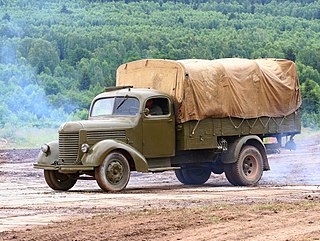
The Praga RN was a medium-sized truck manufactured by Praga from 1933. The vehicle was powered by a six-cylinder petrol engine. From 1934, the diesel-powered version Praga RND was also manufactured. The trucks were manufactured for nearly three decades and became one of the most widely used freight wagons in Czechoslovakia, the chassis being used for buses and fire engines as well as for military uses. RN production ended in 1953 and RND in 1955, although production continued in Yugoslavia until 1962. In total, around 40,000 Praga RN and RND were produced, including about 3,700 buses, as well as 18,300 RN license built in Yugoslavia.



















